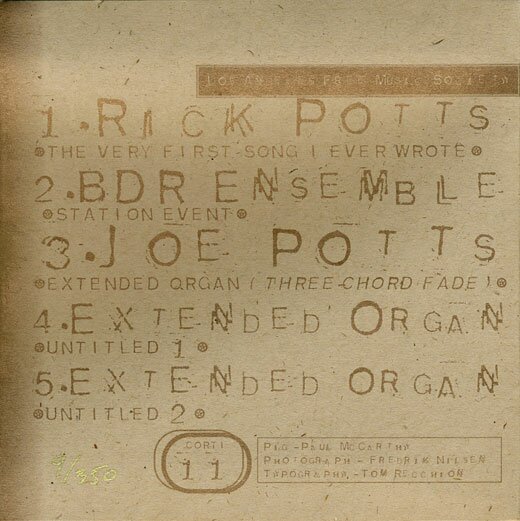performance art
Archived Posts from this Category
Archived Posts from this Category
Posted by thomas-cummins on 14 Sep 2009 | Tagged as: books, essays, performance art
In his short essay ‘Romancing the Looky-Loos‘, Dave Hickey shares his interesting viewpoint on the evolution of coöptation as viewed through its audience. He makes a distinction between Spectators(the titular looky-loos) and the Particiant. You can spectate the full article here or participate with it .
“spectators invariably align themselves with authority. They have neither the time nor the inclination to make decisions. They just love the winning side— the side with the chic building, the gaudy doctorates, and the star-studded cast. They seek out spectacles whose value is confirmed by the normative blessing of institutions and corporations. In these venues, they derive sanctioned pleasure or virtue from an accredited source, and this makes them feel secure, more a part of things. Participants, on the other hand, do not like this feeling. They lose interest at the moment of accreditation, always assuming there is something better out there, something brighter and more desirable, something more in tune with their own agendas. And they may be wrong, of course. The truth may indeed reside in the vision of full professors and corporate moguls, but true participants persist in not believing this. They continue looking.
Thus, while spectators must be lured, participants just appear, looking for that new thing—the thing they always wanted to see—or the old thing that might be seen anew—and having seen it, they seek to invest that thing with new value. They do this simply by showing up; they do it with their body language and casual conversation, with their written commentary, if they are so inclined, and their disposable income, if it falls to hand. Because participants, unlike spectators, do not covertly hate the things they desire. Participants want their views to prevail, so they lobby for the embodiment of what they lack.
The impact of these participatory investments is tangible across the whole range of cultural production. It is more demonstrable, however, in “live arts” like music, theater, and art than in industrial arts like publishing, film, and recording. Because in the “live arts,” participatory investment, as it accumulates, increases the monetary value of the product. You increase the value of an artwork just by buying it, if you are a participant. Thus, you will probably pay more for the next work by that artist you buy. You do the same if you recruit all your friends to go listen to a band in a bar. If all your friends show up and have a good time, you will almost certainly pay more at the door the next time the band plays. But that’s the idea: to increase the social value of the things you love…”
Posted by ben on 18 Aug 2009 | Tagged as: adventure day, art + bikes, arts organizations, performance art, public art, renegade performances

A Los Angeles Urban Ranger explaining something
The LA Times has a story up about the Los Angeles Urban Rangers, a group of “geographers, environmental and art historians, artists, curators, architects, and others” who dress up like park rangers and teach people how to enjoy public urban space responsibly. They lead urban safaris, such as a “guided hike of Hollywood Boulevard that deconstructed the famous street as if it were a natural park.” They teach people how to (legally) enjoy Malibu beach fronts where the homeowners have often (illegally) posted “Private Beach” signs.
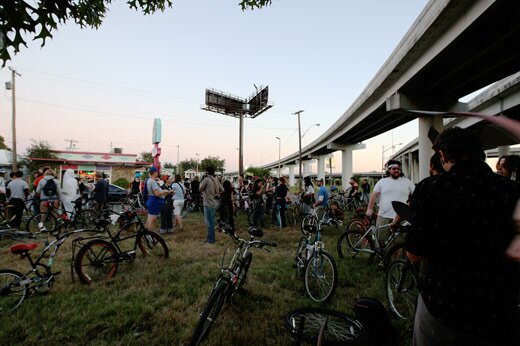
San Antonio's Bike Gang Summit, 2008 (photo: Justin Parr)
This is what performance art should be: seductively entertaining while challenging implicit assumptions about what constitutes public space and how it should be used. In their own way, the Final Friday bike rides (and Bike Gang Summits) in San Antonio encourage this kind of urban exploration, albeit with less explicitly pedagogical goals. Mark Jones and the rides’ other organizers lead bikers through obscure urban environments on the edges of downtown, descending on unlikely VFW halls and pocket parks. It’s a social sculpture if there ever was one.
Posted by thomas-cummins on 29 Jul 2009 | Tagged as: celebrations, in yo face, performance art, r.i.p., renegade performances
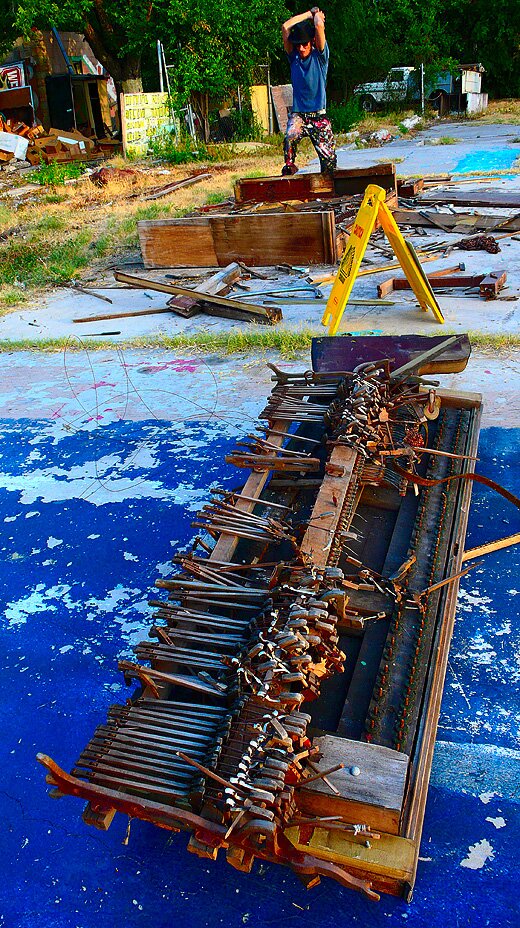
“ and Skye Cosby will be destroying a historic piano upon which music legends such as Sam Cooke have played. The piano was a gift from the late artist Reverend Seymour Perkins’ family to commemorate his artistic career and legacy. Perkins and Castellanos collaborated extensively for the last 2 years of Perkins’ life. Afterwards, Castellanos will build a wall sculpture out of the piano pieces…” -Raul’s MySpace
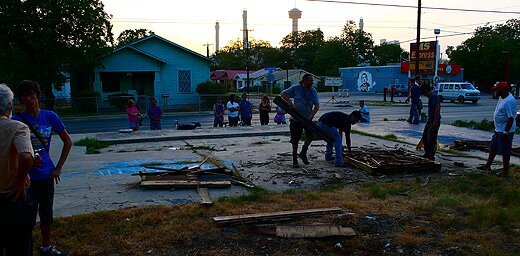
“My performance partner suffered a heat stroke last week cancelling our performance but we are now able to guarantee that on Tuesday the 28th, at 7:45 PM, at 602 Nevada (and Hackberry) at Reverend Seymour Perkins’ famous cement slab/sculpture garden, I, Raul Castellanos, will be breaking a piano given to me by the Perkins family to honor the late controversial and legendary artist from the Eastside. My assistant is Skye who is also Perkins’ only authorized biographer. I collaborated on many projects with Perkins for a bit more than 2 years and was truly honored to do so.” -Raul’s MySpace
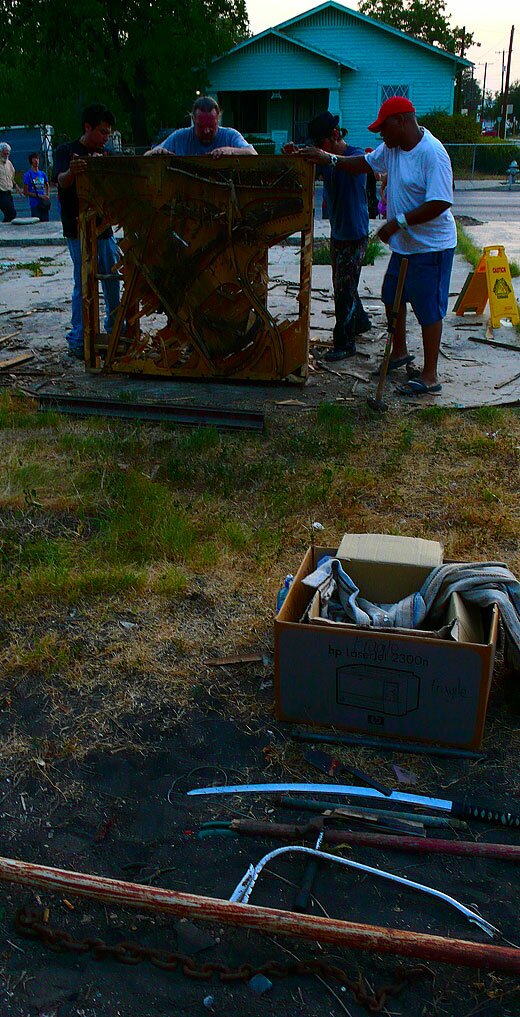
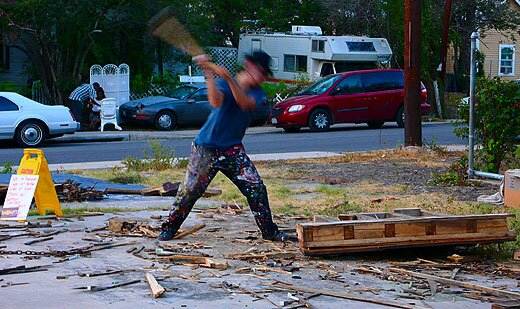
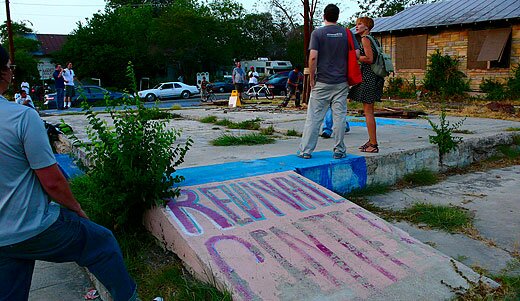
It’s hard to believe, but this event was actually as good as it sounded. Raul once had an art studio next to mine and he was always pretty intense- destroying perfectly good instruments to create paintings and sculptures that helped him represent his deafness to the world. Destroying this antique, though, seemed particularly irreverent as well as the fact that, this time, his chaotic artistic performance was taking place in the middle of one of San Antonio’s poorer black neighborhoods. For the most part, passing cars would just honk curiously at the gathering crowd. There were moments, though, when this art crowd might have felt they were on the wrong side of Sunset Station. One passing neighbor yelled at a nervous spectator and told him to put the piano back together. Overall, though, I felt a real sense of community built between artists, San Antonians, and the recently bereaved. It has often been said that in art- in order to create, you must destroy. What better place, then, than at the Reverend’s Revival Center which once strived to rebuild the tattered remains of strung-out lives.
UPDATE: A video of the event was just uploaded to .
Posted by justin on 22 May 2009 | Tagged as: adventure day, art paparazzi, performance art, possibilities
Nate Cassie gives Jonathan Monk a haircut, prior to the opening of “Rew-Shay Hood Project Part II,” at Artpace.
(photo by Justin Parr)
Posted by ben on 20 Apr 2009 | Tagged as: architecture, arts organizations, celebrations, performance art, public art, r.i.p., video/film
When I was working on my first art review back in 2006, I saw a version of Edgar Arceneaux’s video “Old Man Hill” at the Artpace potluck that launched his residency there. The residency project (which later wound up in the Whitney Biennial) wasn’t as impressive as this simple homage to a man he never met: his father’s father. Arceneaux spelled out the only thing he ever knew about this man — that he was called “Old Man Hill” — in silver balloons, which hovered over the war-torn hills of Sarajevo. One by one the balloons released and twisted toward the sky. The cameras followed the balloons wistfully, clinging to these insubstantial forms seeking oblivion. Occasionally the cameras cut to people going about their lives in the city below, people looking away from these hills with their burned out buildings and piles of rubble.
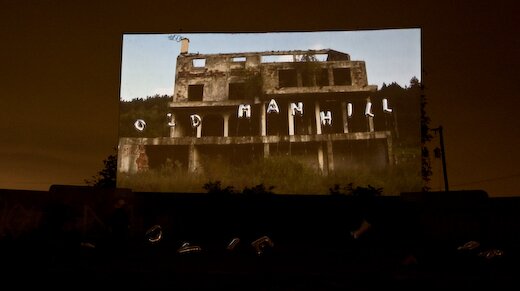
Linda Pace, who had not yet embarked on her battle with cancer, purchased this piece for her collection. Other than that potluck, the video had never been shown publicly; but before she died, Linda asked that it be screened at a special time, with the artist present. The Linda Pace Foundation arranged to screen the final version of this video for Linda’s birthday, last Thursday. Arceneaux was flown in to stage a performance along with the screening. The site selected for the project was the Mission Drive-In, a once-popular drive-in theater now dilapidated, graffiti-strewn, and slated for destruction. (It will be replaced with a new public library).
The evening of the event was overcast, windy, threatening rain. We got there early, and wandered around the old drive-in, its pavement giving way to grass, but its screens still fully intact. One by one, silver balloons were filled up and placed in front of the main screen, spelling out words that were unfamiliar to us, apparently a translation of “Old Man Hill” into Serbian Bosnian.
The translation of words hinted at another translation: the bombed-out hills of Sarajevo where snipers once found cover were translated into a theater in San Antonio, equally desolate, undergoing a wholly other kind of violence. This isn’t to equate the devestation of war to the disappearance of a drive-in, but to translate loss between cultures. Nearby the old theater, the Mission San Jose holds memories of a violence closer to that of Sarajevo: genocide, slavery, subjugation. But to most of us living in San Antonio today, the loss of place is felt more fully than the tragic, large-scale loss of life experienced by those who lived in Sarajevo in the 1990s or San Antonio in the 1700s. The slow erosion of the identities of our cities happens to be the kind of loss we are stuggling with now, the loss that we still don’t quite know how to grapple with.
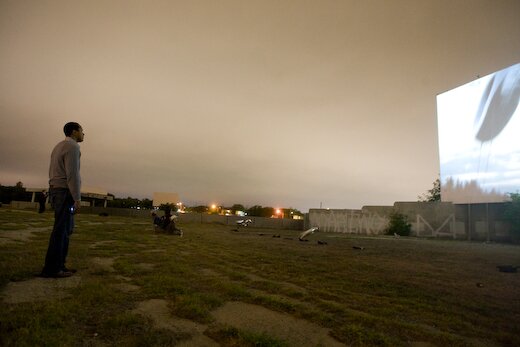
Eventually, as it grew dark, Arceneaux introduced the video, speaking of his search to learn something of his grandfather, a man neither he nor his father ever knew. This was a search to connect his identity to something larger, something more historically rooted. He spoke of his brief relationship with Linda Pace, who worked to create places in San Antonio that connect to what came before them: an old car dealership downtown becomes an artist residency space. This is the act of translating place — it doesn’t make sense to have car dealerships downtown anymore, but these spaces can be translated into something that is meaningful today, that turns loss and emptiness into another kind of value.
The video started, and as we watched Old Man Hill float away into the hills of Sarajevo, we also watched indecipherable words from another place float away into the San Antonio night, sometimes brushing slightly against the aging screen. And even as they disappeared from view, these words became embued with meaning. This was the final screening at the Mission Drive-In.
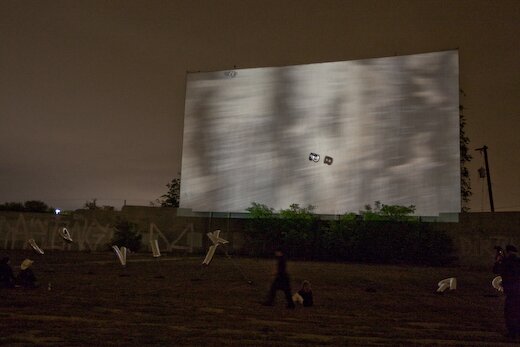
(Photos by Justin Parr, courtesy Linda Pace Foundation)
UPDATE: I’m honored to have Devin King respond to this in the second post on his new blog, Dancing Young Men From High Windows. Hopefully I’ll have time to respond to his post soon, but in the meantime I’ll point yall that way for an interesting reaction.
Posted by justin on 16 Mar 2009 | Tagged as: adventure day, art paparazzi, arts organizations, in yo face, party photos, performance art, possibilities, public art, rock!, silliness
Well, after a good deal of rain, some unexpected cold, and a little bit of worry, Luminaria 2009 turned out to be a really nice night in San Antonio. Aside from my experience with the overbearing police force (who wanted to tackle me for riding my bike down an empty LONG stretch of closed off road) I found this Luminaria to be much better organized and more satisfying to take part in. I carried my camera and photographed the projects I was able to come into personal contact with. Heres a selection of those photos, with my garbled commentary.
Laura Varela & Vaago Weiland collaborated on the Alamo this year. Vaago (from Mönchengladbach, Germany) said, in doing research on the Alamo, he kept coming across these photos with tents in the surrounding area. He was determined to surround the old Mission with 200 tents, however, upon closer inspection of the site was only able to squeeze in 54. Lauras video projection played alongside Vaagos sculpture, within the top of the Alamo.
Hyperbubble was the only real music I stood still and watched an entire set from. Not for lack of interesting options, but more in awe of the reaction of the crowd to their music. I heard more than several proclamations of “WHAT IS THIS?” and “THIS is the best band EVER!!” loudly from behind. I couldn’t have been happier.
My own piece (shamelessplug) was projected onto this old building(I was told it might have been called the Turner Magika Theatre?) facing out into the Hemisphere park, I showed the current version of my “Portrait of the Artist as a City,” a project I took up as a result of receiving a grant from the Artist Foundation. The video is made up of a constantly shifting set of over 9000 still photos, and encompasses more little parts of my life than I can begin to explain before losing your attention.
This year, the real showstopper for me was Ansen Seales 100 ft photograph of the San Antonio River. Contained inside the San Antonio Convention Center, It set the tone for the more conventional “walled,” section of the show. After talking to Ansen for a few minutes I was able to extract from him that this image was composed of 86,400 individual “slitscans,” made by his own homebuilt digital camera, and weighed in at a whopping 1.2 gigs for the file itself…and I thought trying to get my computer to juggle 9000 still photos at one time was tricky.
This fantastic ghost image of a dancer is local artist/instructor Rebecca Dietz. She was one of the roving performance artists, and a recent FL!GHT Gallery featured artist. I nearly missed her moving by me, and was glad I noticed who it was at the last minute.
John Mata, part of Leslie Raymonds New Media program at UTSA, built a cardboard room and filled it with books and media discussing…New Media.
Judith Cottrell & Gary Smith built this human like glowing form, and scared children for the duration of the night. I enjoyed watching.
Holly & Bryson Brooks decided it was best to be “Married with Paintings.” So they walked in at 6 on the dot, started working inside their makeshift studio(replete with audience the entire time), and by the time I rolled around with my camera, they were already at this point within each of their portraits of the other.
Back out on Alamo Street, Ethel Shipton had filled these two store front windows with her characteristic puffed objects, this time being birdhouses.
Kelly O’Connor was just a few windows down. My camera was having trouble not blowing out the detail in this one.
I stumbled upon this projection by Victor Pagona & his wife Sarah Susan, an artist I’ve heard of for years, but never met in San Antonio.
Sadly, I could only get this much of the smaller Leigh Anne Lester window displays without the detail of the sculptures being blown out by the harsh jewelry store lighting. These window displays will be available for all to see for the next month along Alamo Street.
I stumbled over this Michele Monseau projection right across the street from the Alamo, hidden on a side wall.
These patterns & lights can give you a general idea of what everything else looked like, that was not affected in some way by an individual artist or group of artists.
These two large scale Thomas Cummins Lightboxes, while difficult to do justice with a photograph, were mindblowingly detailed in person.
Another fine example of the general lighting scheme found that night. Its almost like that time I had to shoot photos at a certain laser light show..
Jenny Browne gave away 4 shopping cartloads and a truck bed full of books, for FREE, as her piece. It was awesome to see people swarming the truck and carts, trying to get at free books, while Jenny sat on the roof watching & laughing.
..and finally to end the weekend, Tom Otterness made an appearance with his newly unveiled(in our locale at least) public art piece, “Makin Hay’,” mentioned a few weeks back here at Emvergeoning. Some things I’m sorry to say I don’t have good photos of, the first being the EXCELLENT Contemporary Art Month installation by Randy Wallace in the basement of the old Beauty College building on Travis Street. I shot many photos of it, but none of them quite did it justice. I was also sad to miss crazy Mel Feldman and his cultural arts Kaleidoscope. Somehow 1000 artists all in one place on one night is just a LITTLE hard to keep track of.
Posted by aaron on 28 Jan 2009 | Tagged as: music, performance art, r.i.p., vs.
I hope Ben doesn’t mind me borrowing his trademark vs. trope, but I couldn’t resist posting these images. Levitate over them for deeper enlightenment.
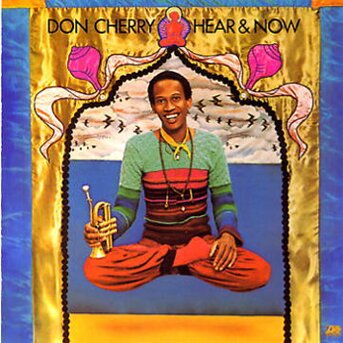
Pocket trumpet master and frequent Ornette Coleman collaborator Don Cherry.
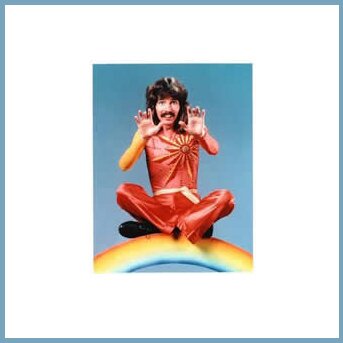
Magical TM devotee and 1970's teevee phenomenon Doug Henning.
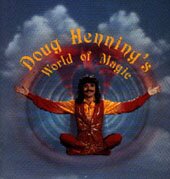
Bonus levitation.
Posted by thomas-cummins on 02 Jan 2009 | Tagged as: performance art
This is a little late notice but after you’re done checking out the shows at First Friday tonight, go to your computer around 9:30 p.m. central time to see Jump-Start’s Web cast that will feature artists from various locations around the world. It should remain true to its namesake and be on-line until about 9:30 tomorrow. It can all be seen at http://24hours24artists.com or better yet go see the performance live starting at 7 p.m. on Saturday at Jump-Start Performance Co. at 108 Blue Star, SA, Tx. First Thursday was pretty dead overall last night due to the New Year’s Day Holiday but also check out “All Ladies Video Review” at UTSA Satellite Space and Susan Oaks’ work at Fiber Artspace.
Posted by ben on 15 Dec 2008 | Tagged as: performance art, poetry, r.i.p., wordy
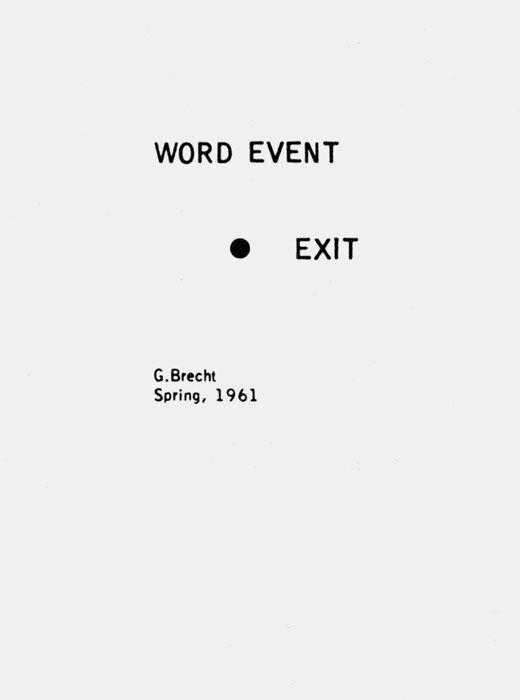
Word Event (George Brecht, 1961)
In their use of language as a device to cut into the evanescent everyday, [George] Brecht’s “insignificant and silly gestures” open an infinite universe of possibilities, just as [La Monte] Young’s precise operations move into the zones of the minimal and the series, of the same but inevitably different because virtually interminably—the line or the sound would go on in some sense “forever.” In both, the event is pared down to a minimum: a simple, basic structure that can be endlessly reenacted and reinscribed in new contexts, different in each instance and yet retaining a certain coherence. Inevitably calling to mind Lawrence Weiner’s highly condensed and yet generalizable “statements,” Brecht’s and Young’s most interesting scores reduce language to a kind of object, but also establish it as a kind of repeatable, replaceable structure, open to unlimited, unforeseeable realizations.
— Liz Kotz,
Posted by justin on 11 Nov 2008 | Tagged as: art paparazzi, party photos, performance art, possibilities, responses/reviews, vs.
Heres a short visual account of the opening affair at Artpace last Thursday night. Richie Budd’s pounding geriatric light show mixed with Taryn Simon’s noise-sensitive Cuttlefish made for an interesting experience..
(Lu Chunsheng’s work, also opened that night, is not pictured).
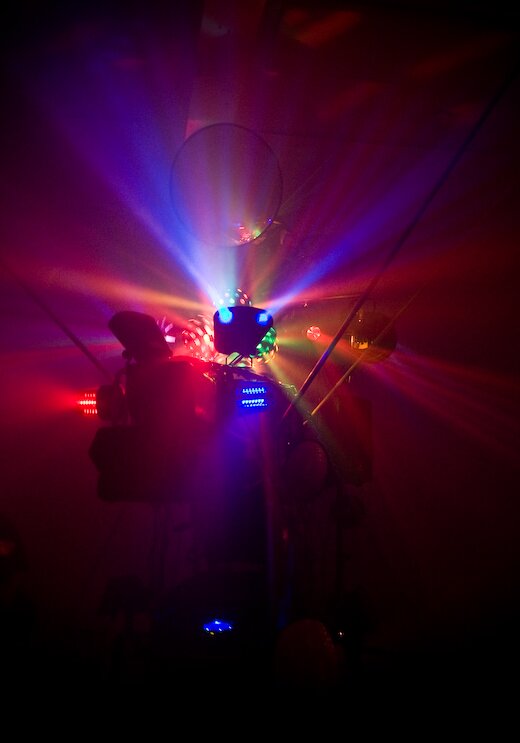
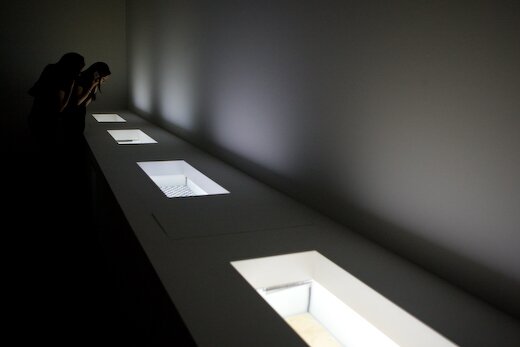
(follow the link for more photos and video of Richie Budd sculpture in action)
Posted by justin on 15 Aug 2008 | Tagged as: acquisitions, adventure day, art paparazzi, performance art, public art, silliness
In between running around shooting photos of record stores and weird museums today, I managed to make it by the Alamo and catch Jacob Goudreault (fresh in town from Chicago, IL) doing a performance / painting give-away in front of our favorite old mission.

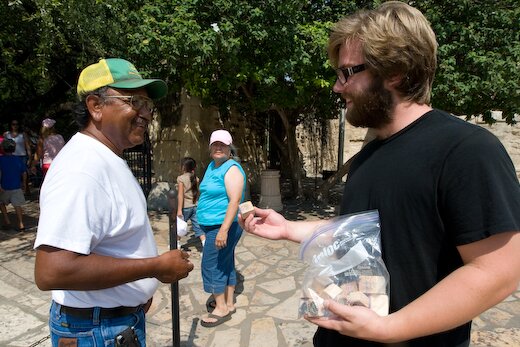

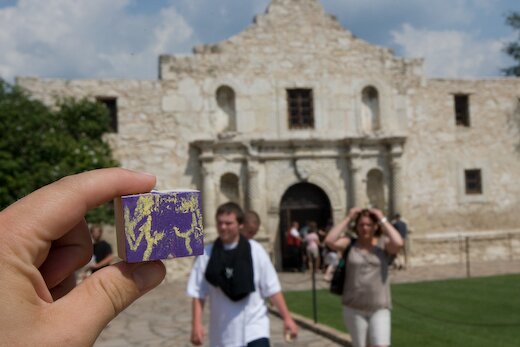
Posted by ben on 11 Aug 2008 | Tagged as: image & sound, music, performance art, sound art
I’m honored to be able to offer a recording of Crevice’s Infinity Asylum performance on this blog. This is a truly beautiful recording by one of the few groups in Texas to successfully bridge the music and art worlds. Infinity Asylum was part of an installation / performance at the Friedrich Building, a 500,000 square foot space on the east side of San Antonio, originally built to produce air conditioners. Tucked away in little nooks and crannies of the building were a number of installations (artists included: Dwayne Bohuslav, Christopher Biasiolli, Nate Cassie, Rae Culbert, and Jack Robbins). As visitors explored the space, Crevice played this “peaceful, hypnotic, cyclical music” (to quote from the original press release), which fell in and out of earshot. Many of the vocals you hear in the recording are samples of people talking about the installations, thus folding audience reaction into the performance. It was recorded on July 11, 2003.
Performers on this recording: Jeff DeCuir (guitar, processors), Jessica Barnett DeCuir (harmonica, percussion), John Navarro (theremin, processors), Bryan Stanchak (synth, bass), Stephen Reyna (guitar/e-bow).
Posted by ben on 27 Jul 2008 | Tagged as: art paparazzi, design, party photos, performance art, public art, silliness, video/film
Emvergeoning’s exclusive footage from the 2008 Pushcart Derby:
Posted by ben on 24 Jul 2008 | Tagged as: design, interviews, performance art, public art, renegade performances, silliness
Matt Fleeger from KRTU 91.7 (where I am a volunteer DJ) just sent us his interview with Cruz Ortiz about the Contemporary Art Month Pushcart Derby. The interview aired this airs tomorrow morning, and the Derby is this Saturday at Dignowity Park (see our event listing). We’ll be posting photos and video of the derby for those of you out there who crave mediation. Click on the little play button below to listen.
Posted by justin on 21 Jul 2008 | Tagged as: art + bikes, art paparazzi, image & sound, performance art, photography, renegade performances, video/film
Posted by ben on 11 Jul 2008 | Tagged as: announcements, music, performance art, upcoming events
Since we’ve been incredibly lazy with the upcoming events list lately (please don’t hate us), I thought I’d highlight a couple of events happening tonight that should be fun: the Hometown Artist’s Rodeo at the Cove and Exhibit with a “Z” at SoHo.
The Hometown Artist’s Rodeo was once a monthly event featuring performances by many of San Antonio’s more talented artists and musicians. Ken Little resurrected the show just for July. Performers will include Ken Little with Rodeo Ho Ho, The Mark Little Jazz Experiment, Hills Snyder, Gary Sweeney, Chris Sauter & Rick Frederick, and Jason Trevino. There’s a $5 cover and the show goes from 8 pm to midnight. The Cove is located at 606 W. Cypress.
Exhibit with a “Z” includes new work by Alejandro Diaz, Kristy Perez, and Hector Ruiz, with appearances by tequila and empanadas. The show is organized by Franco Mondini-Ruiz and David Shelton. This one also runs from 8 pm to midnight. SoHo is located at 214 W. Crockett.
Posted by ben on 10 Jul 2008 | Tagged as: music, performance art, r.i.p., rock!, video/film
I just learned that Bruce Connor died on Tuesday. Here’s a wonderful little film he made in 1966 featuring the dancing of Toni Basil (aka Antonia Christina Basilotta) and the music of Ed Cobb (NSFW — there are a few nude shots):
Posted by ben on 02 Jul 2008 | Tagged as: essays, performance art, politics, renegade performances, responses/reviews
My admittedly slow-on-the-draw take on the Aliza Shvarts controversy was just published in the Current:
Art can be viewed as a sort of safe space in which society allows itself to push moral boundaries with the understanding that the artist is asking a question. Behavior that would otherwise be proscribed is permitted in order to catalyze moral evolution. We can draw analogies here to other safe spaces that humans set up in order to take otherwise unacceptable risks: the boxing ring, the therapist’s office, even the dreamworld, where desires and fears are explored without physical commitment. Therapeutic uses of art are well established, as is the connection between dreams and artistic production.
Problems arise, however, when the boundary between art and life is blurred. When we move from image to enactment, a crucial line has been crossed, and the artistic space becomes not so safe. As much as morally questionable performances have been integrated into the artistic canon, it is possible that they will always provoke trepidation, if not outrage, in the general public.
Further reading:
Posted by michelle on 14 May 2008 | Tagged as: music, performance art
Posted by ben on 23 Apr 2008 | Tagged as: performance art, responses/reviews, video/film
I have a piece in last week’s Current discussing the work of Regina José Galindo (currently at Artpace). It’s not so much a review as a discussion of the history of Galindo’s work, and the way that it brings protest strategies into a visual art context. There’s a lot I couldn’t get to in that article, though, and thought I might dig into that a little bit here.
One thing that struck me about the work at Artpace is the contrasting uses of performance and documentation by Kate Gilmore, Regina José Galindo, and Margarita Cabrera. (Although Rodney McMillian incorporated performance and documentation into his work, for various reasons I won’t be discussing him in this post.) Galindo’s performance draws from a protest tradition — at Artpace, she locked herself along with her husband and daughter in a mobile prison cell in the gallery. Also, like a protester, she views her performances as her artwork, while the videos and photographs that are generated from them are purely documentation of the performance — not individual works of art, but necessary to spread “word of the performance and the message.” However, when she discusses her intentions and expectations, Galindo never mentions social change:
I suppose that—like everything I do—this was done for me…. I never have any expectations after completing something. What I do have is a certain amount of nervousness and anxiety before every performance. But after that I have no expectations. It’s done.
So in this way at least, it is distinct from protest which aims to catalyze social change.
Like Galindo, Kate Gilmore puts herself into dangerous or difficult situations in order to comment from a personal perspective on the systemic problems that prevent human progress. But the similarities end there. Gilmore’s work consists of performances on video (the videos being, in this case, the artworks, while the performances become simply part of the process of creating the work). The situations Gilmore puts herself in don’t target material injustices, but are created by the artist. She sets her foot in a bucket of cement, lets the cement dry, and then sets about the task of breaking her foot out of the cement with a hammer. This kind self-imposed task suggests an allegorical confrontation with psychological barriers more than a way to address specific injustices (although these barriers are connected to societal inequities).
Margarita Cabrera takes a different tack. She turns the gallery space into a makeshift copper butterfly factory, and recruits community volunteers to make 2,500 butterflies by hand. This strategy recalls the work of Harrell Fletcher, who often addresses divisions within communities by organizing collaborative events. However, Cabrera does, like Galindo, deal with concrete issues of ongoing social injustice. The workshop Cabrera builds is meant to signify the maquiladoras (low-wage manual labor factories, often with lax labor law enforcement) in Mexico. By “exporting” the butterflies to the home of a wealthy San Antonio collector, Cabrera targets economic systems that hide the human costs of a product from its owners by separating the craft from the craftsman. The documentation plays a minor role in this work: a photograph of the butterfly installation is affixed to the wall of the workshop. In another parallel to Galindo’s work, Cabrera leaves the workshop for gallery visitors to explore, so that a trip to the gallery gets you an experience of the residue of her artwork.
The interplay between these exhibits helps flesh out the contours of performance in contemporary art. Each artist works with performance strategies that articulate a distinct relationship between artist and community. By placing these shows side-by-side, Artpace encourages the visitor to contemplate approaches to social critique: The direct, literal commentary of Galindo, or the allegory of Gilmore. The interpersonal relations of Cabrera or the personal goals of Galindo. The roles of document and sediment in the artistic process.
Posted by justin on 09 Apr 2008 | Tagged as: art + bikes, art paparazzi, celebrity sightings, performance art, renegade performances, rock!, silliness
Ken Littles Rodeo HO HO made its final REGULAR appearance last night. See for yourself :
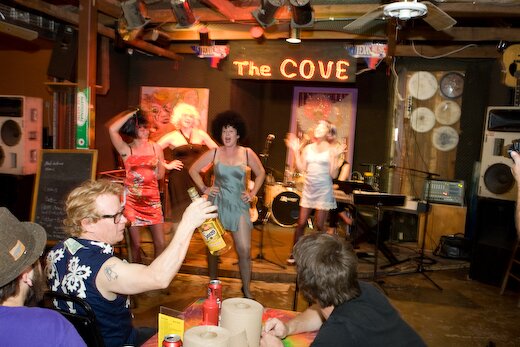
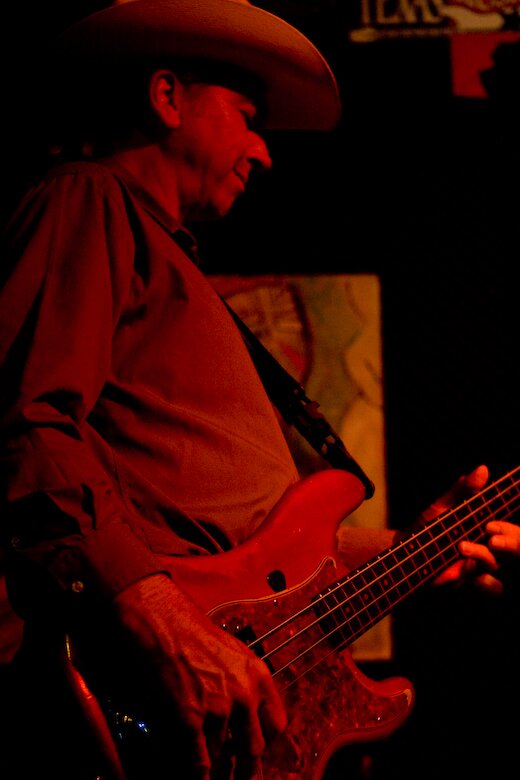

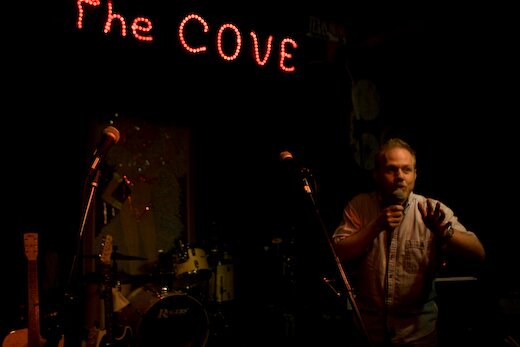
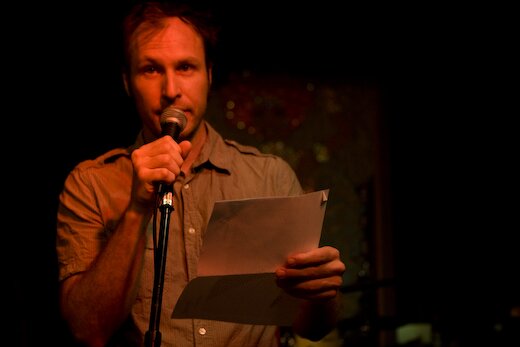
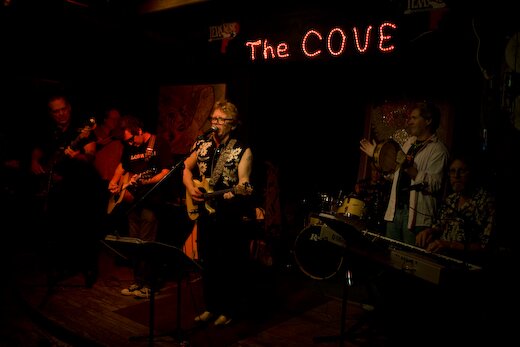
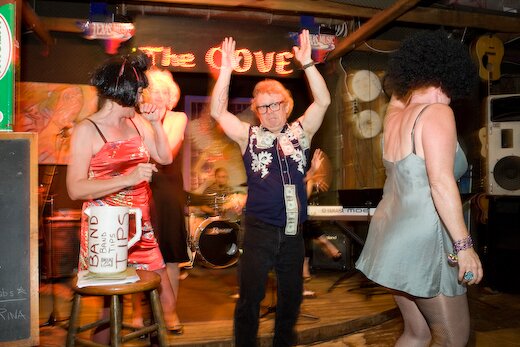
Posted by ben on 06 Apr 2008 | Tagged as: art paparazzi, celebrity sightings, in yo face, mustaches, party photos, performance art, renegade performances, rock!, silliness
Everything got screwed up. Emvergeoning’s calendar editor forgot to post Ms. Southtown, San Antonio’s artsiest drag beauty pageant, to our events listing; last night, when Ms. Southtown was happening, our trusty photographer was out working for The Man; and our amateur backup paparazzo filled up the camera memory right before the trophy was handed to the winner. I guess that’s why we don’t get the big bucks, and why I’m typing this from a cardboard box in an alleyway off Houston St. But here it is: Ms. Southtown in photos.
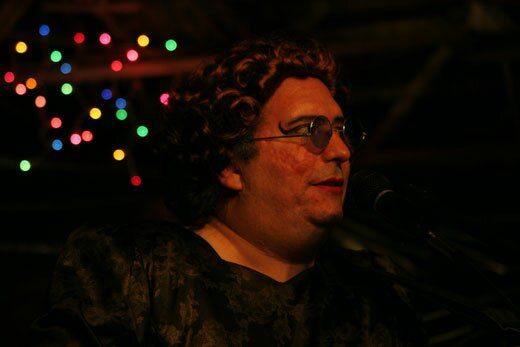
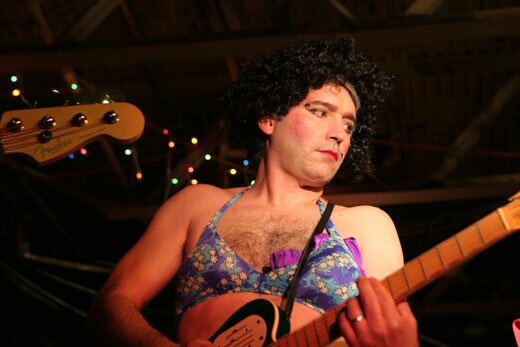
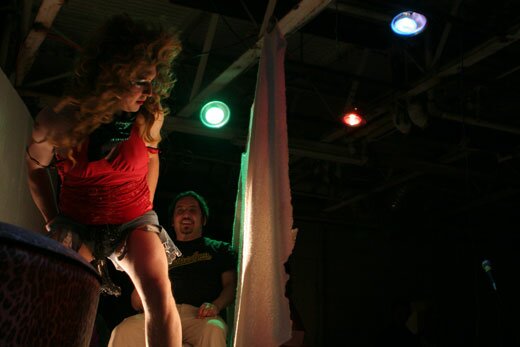
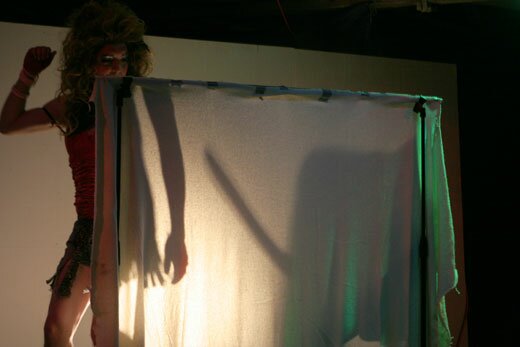
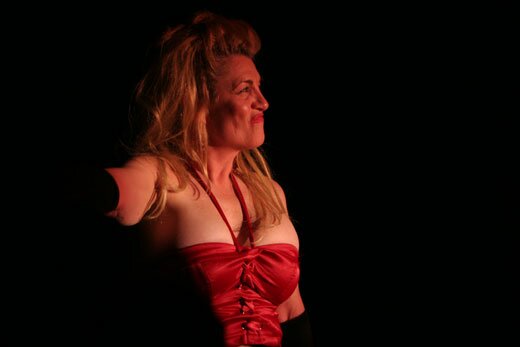
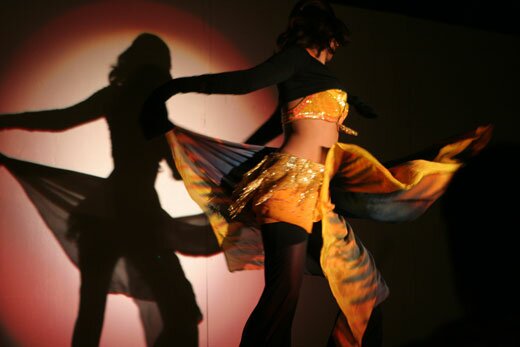
Posted by ben on 04 Apr 2008 | Tagged as: design, image & sound, music, performance art

In another attempt to explore the intersection of music and visual art (see also), I give you a rare Los Angeles Free Music Society CD, on which Paul McCarthy plays alongside fellow artists John Duncan and Tom Recchion, photographer Fredrik Nilsen, and noise pioneer Joe Potts (of Airways). Included with an edition of The Lowest Form of Music box set, this CD includes a 30-minute organ drone by Potts, a recording of a radio “event” by the BDR Ensemble (Michael Delle Donne-Bhennet, John Duncan, and Tom Recchion), and some indescribable weirdness from Extended Organ (Joe Potts, Fredrik Nilsen, Paul McCarthy, and Tom Recchion). I’m including a few notes on the recordings below.
“3 CHANNEL CHORDS” was produced in an attempt to create an undulating mass of sound which seemed at first to be static drone while actually being a complex constantly mutating entity. The music was recorded in these separate takes on three tracks. Each track has sixteen channels of “CHOPPED OPTIGAN” run through a stereo mixer with the slide pots arranged to form a sine-wave pattern. Overt the course of thirty-plus minutes the sliders are constantly adjusted so that the sine pattern ripples across the mixer and then returns to the starting position. This formula is repeated on three separate channels, and then mixed down to stereo. I performed it and Rick Potts engineered it in his studio/living room. This recording marks the debut of the CHOPPED OPTIGAN.
— Joe Potts

BDR Ensemble: Michael Delle Donne-Bhennet / John Duncan / Tom Recchion * KPFK 90.7 FM-Los Angeles * Sponsored by Close Radio * December 1, 1977 * Duration 80 Minutes
Station Event was intended to use as a medium of communication rather than one of broadcast. It was performed live over Close Radio from two separate rooms: Delle Donne Bhennet (woodwinds and percussion), Recchion (invented instruments, piano and available materials) performed in KPFK’s Studio A. Paul McCarthy joined them toward the end of the work. From the control room, Duncan asked for and monitored phoned-in responses to what the ensemble was doing. Telephone calls and music from Studio A were mixed at the discretion of Steve Tyler, night engineer at KPFK. The two rooms were sound-separated, Tyler alone was able to hear the complete broadcast at its source.
— Tom Recchion
